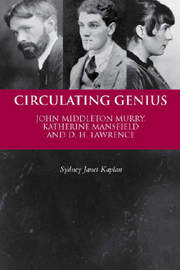Book contents
- Frontmatter
- Contents
- Acknowledgements
- Abbreviations
- Introduction
- 1 ‘My Blundering Way of Learning’: Murry's Still Life
- 2 Still Life and Women in Love
- 3 From Still Life to ‘Bliss’
- 4 ‘A Furious Bliss’
- 5 ‘With Cannonballs for Eyes’
- 6 ‘The Coming Man and Woman’
- 7 The Things We Are
- 8 Circulating Mansfield
- 9 Circulating Lawrence
- 10 Circulating Murry
- Bibliography
- Index
2 - Still Life and Women in Love
Published online by Cambridge University Press: 12 September 2012
- Frontmatter
- Contents
- Acknowledgements
- Abbreviations
- Introduction
- 1 ‘My Blundering Way of Learning’: Murry's Still Life
- 2 Still Life and Women in Love
- 3 From Still Life to ‘Bliss’
- 4 ‘A Furious Bliss’
- 5 ‘With Cannonballs for Eyes’
- 6 ‘The Coming Man and Woman’
- 7 The Things We Are
- 8 Circulating Mansfield
- 9 Circulating Lawrence
- 10 Circulating Murry
- Bibliography
- Index
Summary
According to Murry, he only sought from Lawrence ‘the warmth and security of personal affection’ when he visited Greatham in February 1915. He later recognised that Lawrence's response to his need was more complex: ‘What his consciousness required was an impersonal bond between us: that we should be servants of the same purpose, disciples of the same ideal’ (BTW: 332). Murry was confused by that because ‘ideas and purposes meant nothing to me. Persons were everything … But when, as now, we were intimately together, I felt that Lawrence was making a personal appeal to me to follow him impersonally’ (BTW: 332). Murry admitted that he had not been completely honest in professing to accept Lawrence's ideas, but was more ‘like a woman instinctively humouring her husband by accepting his argument and principles, although in fact they are quite indifferent to her’ (BTW: 333). He was ‘uneasy’ about his own willingness to go along with Lawrence in this way, which, as his awkward simile suggests, placed him in the ‘feminine’ role in their relationship. During that conversation on 21 February, Lawrence was to make a statement that would have significant long-range implications in the relations between the two men. Murry writes that Lawrence ‘was sad, for he was a forerunner, like John the Baptist before the Christ, whose place it was to give up & surrender’ (BTW: 336).
- Type
- Chapter
- Information
- Circulating GeniusJohn Middleton Murry Katherine Mansfield and D. H. Lawrence, pp. 38 - 56Publisher: Edinburgh University PressPrint publication year: 2010



